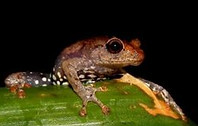
Research interests & areas of expertise
Evolutionary processes in mountains
Mountains host over 80 % of the global terrestrial diversity in less than 15% of the world´s surface, however our understanding of the processes that had shaped such diverse biotas is far from complete. In recent years I have combined several approaches in different geographic scales to tackle this question.


Heredity, 2020
Global Ecology and Biogeography, 2021
Global Change
I am deeply interested in understanding and quantifying the impacts on biodiversity of contemporary threats such as climate change and biological invasions. In my current position at UniVie I will be developing projects related to climatic niche dynamics during biological invasions, the drivers of invasions in mountainous regions and its impacts worldwide


In preparation
Conservation
When I started studying frogs in Costa Rica, the global amphibian decline crisis was at its apex. For this reason part of my efforts has been oriented to addressed questions regarding the underlying causes of amphibian declines and the spatial patterns of these events. Here, most of my work is related to emergent diseases and the distribution of Bd and Bsal

Biotropica,, 2020

Submitted
Species discovery
Documenting biodiversity is a fundamental step in our goal of understanding nature. During my career, I have been deeply interested in exploring of remote areas in the mountainous environments of Costa Rica. As a result of these expeditions, I have been involved in the discovery of various species of frogs and salamanders and we have more comming soon!



Zootaxa,, 2019
Zootaxa,, 2012
Zootaxa,, 2009
Natural history
As a Neotropical biologist, much of my formation came from long field trips in the heterogeneous landscapes of Costa Rica during my undergrad years. Although I am increasingly using large available datasets and computational approaches in my current projects I am still convinced that the more interesting questions raise from the patient observation of natural phenomena in situ.

Mesoamerican Herpetology, 2015

Phyllomedusa, 2014